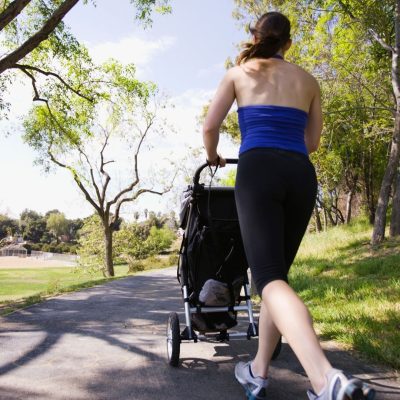In this blog when we refer to women/females we are referring to those presumed female at birth.
The American College Of Obstetricians and Gynaecologists produce some great guidelines for the general public and health practitioners to follow on return to exercise post birth.
So when is it safe to return to general exercise?
Exercise After Any Delivery
All women are encouraged to exercise after the birth of a baby for all sorts of reasons including especially mental health and overall wellbeing. A Study showed that getting out with your baby in a pram to walk on a daily basis correlated with good mental health.
Walking is low impact and can be started safely whenever a new Mum feels up to it.
But as a general rule, the first 6 weeks are a time to recover and recuperate after the delivery: it is a time to establish feeding patterns if breastfeeding: a time to get to know your baby: a time to take it easy if nights are disturbed and rest in the day when your baby rests.
This all gets tougher if you have an older toddler or other children to attend to. But all family members need to be aware that Mum needs to have time to recover in those first 6 weeks before the 6 week Doctor’s check…the house might not be in ship shape, other family members might be helping prepare meals etc.
Exercise Specifically After a Normal Vaginal Delivery
First Six Weeks
It is safe to start pelvic floor exercise and “inner core” exercise: as soon as you feel able after the delivery. Inner core refers to working the deep abdominal muscle with your pelvic floor to start recovery of abdominal muscle strength (see blogs on DRAM).
After your 6 week check you can start to get back to more organised exercise if you wish.
Whatever your goal is, you can set the goal and start working back to it. But remember, for some people, pelvic floor takes more time to recover and return to higher level exercise will be slower for them than for others.
The factors to pay attention to are:
- Forceps assisted vaginal delivery.
- Vaginal delivery of a baby more than 4kgs.
- A long pushing phase of labour of more than an hour.
- A third or fourth degree tear (where you were taken to theatre to be stitched).
These are all deliveries that put more stress on the pelvic floor. If you have any doubts about the ability to do pelvic floor exercise, come and see us to find out what to do.
Six to Twelve Weeks
But for those feeling confident, from 6 weeks you might start doing more demanding, non-impact exercise like basic floor exercises (bridges, modified planks, small range squats, oblique crunches, crunches, aerobic exercise with supported pelvic floor such as stationery bike, upper body exercise on a fit ball etc etc). If in doubt about whether you have a large abdominal separation, it’s best to come in for a check. A sign of problems is when doming occurs.
See below under “caesareans” for an explanation.

From Twelve Weeks
Return to impact ie break into jog or short running is considered safe from 12 weeks.
BUT, if you experience any of the following you should stop and seek an assessment:
- Pelvic heavy sensation
- Pain anywhere in the back of pelvis, front of pelvis, low back pain.
- Leakage of urine whilst running.
- Bowel urgency or issues.
These are all signs that the pelvic floor might be weak.

Exercise After A Caesarean
The timeline for return to exercise after a caesarean is the same as normal vaginal delivery: first 6 weeks recovery and basic pelvic floor and deep “inner core” activation.
Women who have had caesareans expect to find pelvic floor recovery is quicker than vaginal delivery but many women struggle to regain abdominal muscles strength.
From 6 weeks, abdominal muscle strengthening can progress to include more loaded exercise, but as with vaginal delivery, you want to make sure that pelvic floor and lower the tummy works together and switches on to prevent any doming effect at the tummy. If doming is present as you try and increase exercise, it is worth coming in for assessment.
The doming effect is where the midline of the tummy between pubic bone and ribs bulges in a line when you stress the abdominal muscles for example like doing a sit up type movement to get out of bed.

If all is going well, impact exercise like running can start from 12 weeks.
A note of caution: PELVIC PAIN
If you have had pelvic pain in pregnancy that doesn’t resolve quickly after the delivery, we do recommend that you seek specific advice. Pregnancy related pelvic girdle pain can link with pelvic floor weakness, increased tone pelvic floor (tight muscles that don’t relax well). You will need to regain great inner and outer core strength. Book in for an appointment for more information if this is your concern.



